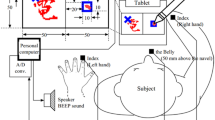Abstract
Handwriting production is viewed as a constrained modulation of an underlying oscillatory process. Coupled oscillations in horizontal and vertical directions produce letter forms, and when superimposed on a rightward constant velocity horizontal sweep result in spatially separated letters. Modulation of the vertical oscillation is responsible for control of letter height. Modulation of the horizontal oscillation is responsible for control of corner shape through altering phase or amplitude. The vertical velocity zero crossing in the velocity space diagram is important from the standpoint of control. Changing the horizontal velocity value at this zero crossing controls corner shape. Changing the slope at this zero crossing controls writing slant. The corner shape and slant constraints completely determine the amplitude and phase relations between the two oscillations. This theory applies generally to a number of acceleration oscillation patterns such as sinusoidal rectangular and trapezoidal oscillations. The oscillation theory also provides an explanation for how handwriting might degenerate with speed. An implementation of the theory in the context of the spring muscle model is developed. Here sinusoidal oscillations arise from a purely mechanical source; orthogonal antagonistic spring pairs generate particular cycloids depending on the initial conditions. Modulating between cycloids can be achieved by changing the spring zero settings at the appropriate times. Frequency can be modulated either by shifting between coactivation and alternating activation of the antagonistic springs or by presuming variable spring constant springs. An acceleration and position measuring apparatus was developed for measurements of human handwriting. Measurements of human writing are consistent with the oscillation theory.
Similar content being viewed by others
References
Abelson, H., di Sessa, A., Rudolph, L.: Velocity space and the geometry of planetary orbits. Am. J. Phys. 43, 579–589 (1975)
Bizzi, E., Polit, A., Morasso, P.: Mechanisms underlying achievement of final head position. J. Neurophys. 39, 435–444 (1976)
Crane, H.D., Savoie, R.E.: An on-line data entry system for handprinted characters. Computer, March 1977, 43–50 (1977)
Denier van der Gon, J.J., Thuring, J.Ph.: The guiding of human writing movements. Kybernetik 2, 145–148 (1965)
Eden, M.: Handwriting generation and recognition. In: Recognizing patterns, Kolers, P.A., Eden, M. (eds.), pp. 138–154. Cambridge, MA: MIT Press 1968
Feldman, A.G.: Change of muscle length due to shift of the equilibrium point of the muscle-load system. Biofizika 19, 534–538 (1974a)
Feldman, A.G.: Control of muscle length. Biofizika 19, 749–753 (1974b)
Grillner, S.: Locomotion in vertebrates: central mechanisms and reflex interaction. Physiol. Rev. 55, 247–304 (1975)
Hagan, P.: Johnny not only can't write: he can't handwrite, either. N.Y. Times Sunday Magazine, May 23, 64 (1976)
Herbst, N.M., Liu, C.N.: Automatic signature verification based on accelerometry. IBM J. Res. Develop., May 1977, 245–253 (1977)
Hertzberg, O.E.: A comparative study of different methods used in teaching beginners to write, No. 214. Teachers College, Columbia University 1926
Koster, W.G., Vredenbregt, J.: Analysis and synthesis of handwriting. In: Biomechanics. II, p. 77. (Medicine and Sport, Vol. 6.) Bern, Stuttgart, Wien: Hans Huber 1977
Lawerence, J.D.: A catalog of special plane curves. Dover: Dover Publ. 1972
McDonald, J.S.: Experimental studies of handwriting signals. RLE Technical Report 443. Cambridge, MA: MIT Press 1966
Mermelstein, P.: Computer recognition of connected handwritten words. PhD Thesis, Massachusetts Institute of Technology 1964
Mermelstein, P., Eden, M.: Experiments on computer recognition of connected handwritten words. Inf. Control 7, 255–270 (1964)
Paul, R.: Modelling trajectory calculation and servoing of a computer controlled arm. Stanford Artificial Intelligence Memo 72, 1972
Pellionisz, A., Llinas, R.: Brain modeling by tensor network theory and computer simulation. The cerebellum: distributed processor for predictive coordination. Neuroscience 4, 324–348 (1979)
Rack, P.M.H., Westbury, D.R.: The effects of length and stimulus rate on tension in the isometric cat soleus muscle. J. Physiol. (London) 204, 443–460 (1969)
Raibert, M.H.: Motor control and learning by the state space model. AI-TR-439, MIT Artificial Intelligence Laboratory 1977
Yasuhara, M.: Experimental studies of handwriting process. Rep. Univ. Electro-Comm. 25-2 (Sci. and Tech. Sect.), 233–254 (1975)
Author information
Authors and Affiliations
Rights and permissions
About this article
Cite this article
Hollerbach, J.M. An oscillation theory of handwriting. Biol. Cybern. 39, 139–156 (1981). https://doi.org/10.1007/BF00336740
Received:
Issue Date:
DOI: https://doi.org/10.1007/BF00336740




